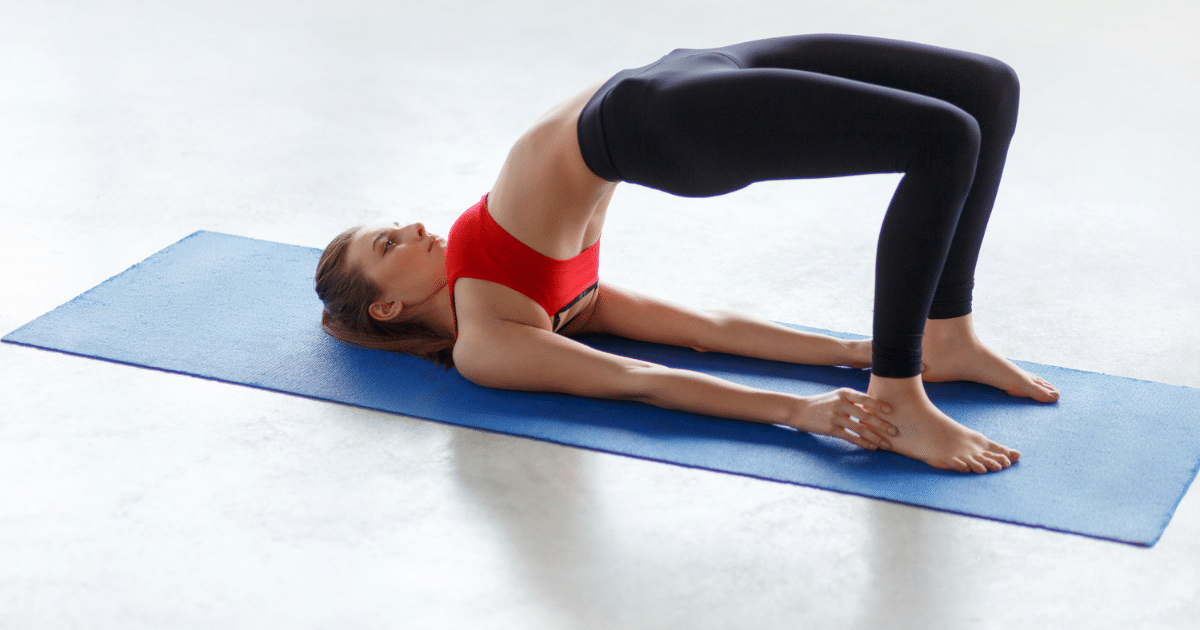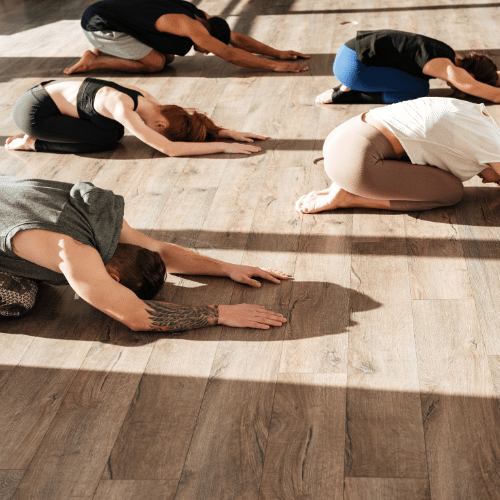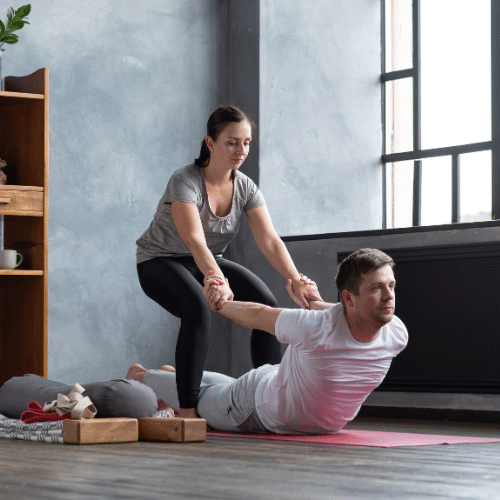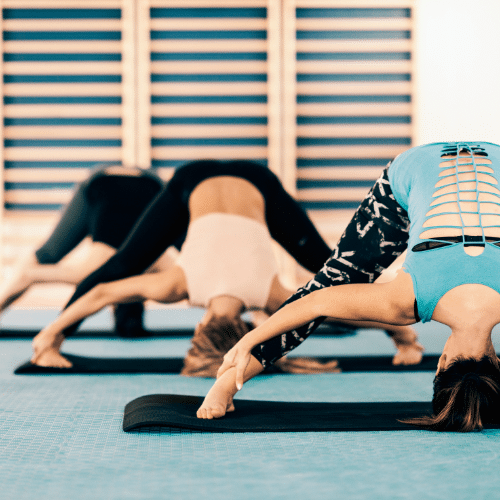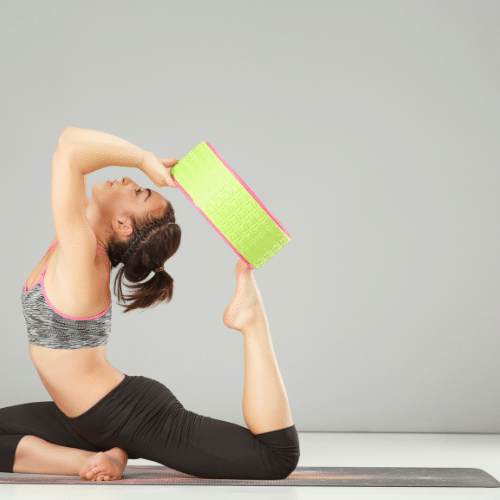Setu Bandha Sarvangasana (Bridge Pose) is a great pose to do when needing to relieve stress or reduce anxiety. When practicing the bridge pose, you are not just working on your core but stretching out any tension in your back, legs, neck, and chest. This asana strengthens the abdomen, back, and arms, thus supporting the heart and lungs. It also helps improve stamina flexibility, gives a feeling of overall well-being, and stimulates the thyroid and pituitary glands, thus balancing the metabolism. The bridge pose can be performed by both beginners and experienced practitioners of yoga.
What Is Bridge Pose and What Are Its Benefits?
The bridge pose is a backbend yoga posture that is suitable for beginners. The bridge pose tones and strengthens the abdominal muscles while also toning the arms, shoulders, and buttocks. It cures lower back pain and improves digestion.
Bridge pose demands strength from your abdominal muscles as you lift your hips with your weight on just two points: your shoulders and the bridge of your feet. Unlike chaturanga dandasana, bridge puts your body weight on your shoulders, so they bear most of the impact as you lift. This pose might not be suitable if you have neck or shoulder injuries.
Bridge pose is also known as Setu Bandha Sarvangasana in Sanskrit.
Beginners can begin by holding the pose for 10 seconds, gradually increasing the time they spend having the stance to one minute as the posture becomes more comfortable. A yoga block can also support the back at the beginning of the practice. For optimal results, repeat the stance, hold it for a few seconds, and then release it three times.
The bridge posture has a wide range of benefits, some of which are as follows:
- It helps to stretch the spine.
- It expands the chest and improves lung function, making it a valuable treatment for respiratory problems such as asthma.
- It stimulates the gastrointestinal organs and aids with digestion.
- It helps to improve blood circulation.
- Menstrual pain and menopausal symptoms can be effectively treated with this medication.
- Can treat back pain and osteoporosis.
- It helps to alleviate sleeplessness.
- Increases the amount of energy
Those who suffer from chronic neck and back pain, on the other hand, should avoid performing this stance.
How To Practice Bridge Pose Safely and Effectively
- Sit in Dandasana (staff pose) – keep your spine erect and put your hands on the floor by your sides, palms facing down. Bend your right knee, bring the heel close to the perineum and rest it on the floor outside your left thigh.
- Exhale and push your right foot away from you. Keep your left leg on the floor and straighten your back, holding your right foot with your hands. Press your elbows against the insides of your upper thighs and begin to lift the bridge.
- Inhale and push up through the topmost part of the sternum, lifting from underneath – not just exhaling into your back. This will give you more lift and strength in your bridge.
- Continue to lift through the bridge until it’s at a comfortable height – knees straight, feet together, grounding down through the four corners of your feet. The crown of your head should be reaching towards the wall behind you.
- Draw your shoulders away from your ears, gently squeezing your shoulder blades together as you lift more. Pull your abdominal muscles in and draw the heads of your thigh bones deeper into their sockets.
- In the bridge pose, it’s essential to open up through the chest and keep a gentle inward rotation of both thighs. This will ensure that the legs work dynamically rather than the gluteals and lower back.
- To release the bridge pose, exhale and slowly lower down onto your mat. Repeat bridge poses three times with an inhaled breath when you lift and three times with an exhaled breath when lowering down.
Tips for Improving Your Bridge Pose
You can strengthen your glutes and core through various methods to prepare for a bridge position. Here are a few workouts that would be beneficial:
Wall Squat
Walking your feet a few steps forward from the wall while standing with your back to the wall is a good exercise. Your back should be supported against the wall. Bend your knees so that you can lower yourself into a squat with your quads working towards a 90-degree angle (parallel) with the floor as you reduce yourself. Keep your knees tracking over your feet, and avoid opening to the sides as you walk. Bring the body back up to the starting posture by pressing down through the feet.
Pelvic Tilt
As you lie down on a mat, your hands should be at your sides. Your knees should be bent and your feet flat on the ground. Take a deep breath and fill your tummy with air. To do this, tilt your pelvis forward as you exhale so that your low back is pressed into the ground and your abdominals are engaged. Take a deep breath and exhale.
Chest Opener
Keeping your back straight, clasp your hands together behind your back. Pulling your arms away from your back will allow you to bring your shoulder heads back and open your chest. Continue to hold for five breaths, and then exhale.
Leg Lift to the Back
Standing tall and straight with your feet as wide as your hips, extend your right leg straight out behind you and repeat on the other side. Squeeze the gluteus maximus to raise the right leg toward the sky and repeat. Continue to hold it for a second before lowering it to the ground. Repeat for a total of ten times, then switch sides.
Variations of Bridge Pose That You Can Try
If you’re looking to add a challenge to your bridge pose practice, or if you’re starting and are looking for some more accessible modifications, check out these variations below!
Glute-Strengthening Bridge Pose
If you’re looking to target your glutes, specifically, the bridge pose is an excellent modification for you. To do this version of bridge pose, place your feet hip-distance apart and lift. Then squeeze your glutes to push your hips upward as high as possible before lowering back down again.
Abductor-Strengthening Bridge Pose
Make sure your feet are hip-distance apart for this bridge pose variation, and your knees and toes point upward. Then push your hips upward and slightly outward and hold for a few breaths before lowering back down.
Adductor-Strengthening Bridge Pose
For this bridge pose variation, bring your feet together so that the insides of both ankles are touching. Then push up onto your feet and hold for a few breaths before lowering back down again.
Hamstring-Strengthening Bridge Pose
For this bridge pose variation, bend your knees and bring the soles of your feet together with your arms. Lift before pushing down on top of your feet to lift as high as you can before lowering back down again.
Conclusion
This pose is sure to be a favorite among practitioners of all levels looking to add a bit of challenge to their practice, as it works the abdominals and hips in ways that we can’t consistently achieve simply by lying flat on the floor. Setu Bandha Sarvangasana is an excellent addition; whether you are just beginning your meditation journey or an advanced practitioner looking to make your adjustments, Setu Bandha Sarvangasana is perfect!
Interested in improving your mindfulness with yoga and bridge pose, grab 30 days of yoga for $30!
Sources:
https://www.yogajournal.com/poses/anatomy/lungs/bridge-pose/
https://www.masterclass.com/articles/bridge-pose-yoga-guide#what-is-bridge-pose


